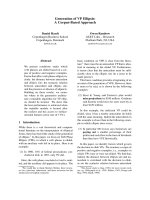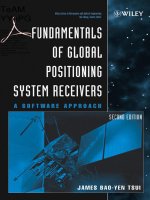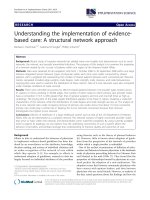Fundamentals of global strategy a business model approach
Bạn đang xem bản rút gọn của tài liệu. Xem và tải ngay bản đầy đủ của tài liệu tại đây (3.76 MB, 272 trang )
KLUYVER
Fundamentals of Global Strategy
A Business Model Approach
Cornelis A. de Kluyver
Cornelis A. de Kluyver is Dean and the James and Shirley Rippey Distinguished
Professor at the Lundquist College of Business at the University of Oregon. Prior
to coming to Eugene, Oregon, he was the Masatoshi Ito Professor of Management at the Peter F. Drucker and Masatoshi Ito Graduate School of Management
at Claremont Graduate University. From 2000 to 2006 he served there as the
Henry Y. Hwang Dean of the School and as Executive Director of the Peter F.
Drucker Research Library and Archives. Prior to coming to Claremont Graduate
University, he held academic appointments at George Mason University, at the
University of Virginia, and at Purdue University. Between 1986 and 1991 he was
a Partner at Cresap, McCormick and Paget, a Towers Perrin company, where he
led numerous global strategy assignments. Dr. de Kluyver has served on several
corporate and nonprofit boards. He was a member of the first Blue Ribbon Commission on Executive Compensation convened by the National Association of
Securities Dealers, which focused on developing standards for stock option
grants. He holds a Ph.D. in Operations Research from Case Western Reserve,
an MBA from the University of Oregon, and undergraduate degrees from the
University of Oregon and Nyenrode Business University in the Netherlands.
Fundamentals of Global Strategy
Fundamentals of Global Strategy will provide you with a strategic perspective of
the opportunities and risks associated with staking out a global competitive
presence. It defines crafting a global strategy in terms of change: how a company should change and adapt its core (domestic) business model to achieve a
competitive advantage as it expands its market presence or sourcing arrangements abroad. The conceptual framework underpinning this definition has
three fundamental building blocks: a company’s core business model, the various strategic decisions a company needs to make as it globalizes its reach, and
a number of globalization strategies for creating a global competitive advantage.
Unique to this book is integration of Pankaj Ghemawat’s well-known AAA
framework for creating global competitive advantage (aggregation, adaptation,
and arbitrage) with a business model approach to strategy formulation. This
format directly links AAA strategies to key globalization decisions associated
with creating a global value proposition, with developing a global market presence, with creating a global supply chain infrastructure, and with adapting a
company’s global organization and management model.
Strategic Management Collection
Mason A. Carpenter, Editor
Fundamentals
of Global
Strategy
A Business Model
Approach
Cornelis A. de Kluyver
Strategic Management Collection
Mason A. Carpenter, Editor
ISBN: 978-1-60649-072-3
90000
www.businessexpertpress.com
9 781606 490723
www.businessexpertpress.com
Fundamentals of
Global Strategy
A Business Model Approach
Fundamentals of
Global Strategy
A Business Model Approach
Cornelis A. de Kluyver
Dean and James and Shirley Rippey Distinguished Professor
Lundquist College of Business
University of Oregon
Fundamentals of Global Strategy
Copyright © Business Expert Press, LLC, 2010.
All rights reserved. No part of this publication may be reproduced,
stored in a retrieval system, or transmitted in any form or by any
means—electronic, mechanical, photocopy, recording, or any other
except for brief quotations, not to exceed 400 words, without the prior
permission of the publisher.
First published in 2010 by
Business Expert Press, LLC
222 East 46th Street, New York, NY 10017
www.businessexpertpress.com
ISBN-13: 978-1-60649-072-3 (paperback)
ISBN-10: 1-60649-072-9 (paperback)
ISBN-13: 978-1-60649-073-0 (e-book)
ISBN-10: 1-60649-073-7 (e-book)
10.4128/9781606490730
A publication in the Business Expert Press Strategic Management
collection
Collection ISSN: 2150-9611 (print)
Collection ISSN: 2150-9646 (electronic)
Cover design by Jonathan Pennell
Interior design by Scribe Inc.
First edition: July 2010
10 9 8 7 6 5 4 3 2 1
Printed in the United States of America.
Abstract
This book looks at the opportunities and risks associated with staking out
a global competitive presence and introduces the fundamentals of global
strategic thinking. We define crafting a global strategy in terms of change:
how a company should change and adapt its core (domestic) business
model to achieve a competitive advantage as it expands globally. The conceptual framework behind this definition has three fundamental building
blocks: a company’s core business model, the various strategic decisions a
company needs to make as it globalizes its operations, and a range of globalization strategies for creating a global competitive advantage.
A business model is defined in terms of four principal components: (a)
market participation—who its customers are, how it reaches them and
relates to them; (b) the value proposition—what a company offers its customers; (c) the supply chain infrastructure—with what resources, activities and partners it creates its offerings; and finally, (d) its management
model—how it organizes and coordinates its operations.
Globalization requires a company to make strategic decisions about
each component of the business model. Market participation decisions
include choosing which specific markets or segments to serve, domestically
or abroad; what methods of distribution to use to reach target customers;
and how to promote and advertise the value proposition. Globalization
decisions about the value proposition touch the full range of tangible and
intangible benefits a company provides to its customers (stakeholders).
Decisions about a company’s value chain infrastructure deal with such
questions as, What key internal resources and capabilities has the company created to support the chosen value proposition and target markets?
What partner network has it assembled to support the business model?
How are these activities organized into an overall, coherent value creation
and delivery model? Finally, strategic decisions about the global management dimension are concerned with a company’s choices about a suitable
global organizational structure and decision-making process.
We use Pankaj Ghemawat’s well-known “AAA Triangle” framework to
define three generic approaches to global value creation. Adaptation strategies seek to increase revenues and market share by tailoring one or more
components of a company’s business model to suit local requirements or
preferences. Aggregation strategies focus on achieving economies of scale
or scope by creating regional or global efficiencies; they typically involve
standardizing a significant portion of the value proposition and grouping
together development and production processes. Arbitrage is about exploiting economic or other differences between national or regional markets,
usually by locating separate parts of the supply chain in different places.
Key Words
Global strategy, global competitive advantage, business model, value creation, value proposition, value disciplines, market participation, supply
chain infrastructure, global management model, global industry, global
branding, innovation, outsourcing, offshoring
Contents
List of Figures . . . . . . . . . . . . . . . . . . . . . . . . . . . . . . . . . . . . . . . . . . viii
Preface . . . . . . . . . . . . . . . . . . . . . . . . . . . . . . . . . . . . . . . . . . . . . . . . ix
Acknowledgments. . . . . . . . . . . . . . . . . . . . . . . . . . . . . . . . . . . . . . . . xiii
Part I
Understanding Globalization. . . . . . . . . 1
Chapter 1 Competing in a Global World. . . . . . . . . . . . . . . . . . . . 3
Chapter 2 The Globalization of Companies and Industries . . . . . 23
Chapter 3 Generic Strategies for Global Value Creation. . . . . . . . 43
Chapter 4 Global Strategy as Business Model Change . . . . . . . . . 65
Part IIGlobalizing the Business Model . . . . . . 91
Chapter 5 Target Markets and Modes of Entry. . . . . . . . . . . . . . . 93
Chapter 6 Globalizing the Value Proposition. . . . . . . . . . . . . . . 115
Chapter 7 Global Branding . . . . . . . . . . . . . . . . . . . . . . . . . . . . 139
Chapter 8 Globalizing the Value Chain Infrastructure. . . . . . . . 161
Chapter 9 Global Supply-Chain Management. . . . . . . . . . . . . . 185
Chapter 10 Globalizing the Management Model. . . . . . . . . . . . . 203
Appendix A Global Trade: Doctrines and Regulation . . . . . . . . . . 225
Appendix B Suggested Cases. . . . . . . . . . . . . . . . . . . . . . . . . . . . . 235
Notes. . . . . . . . . . . . . . . . . . . . . . . . . . . . . . . . . . . . . . . . . . . . . . . . 239
References . . . . . . . . . . . . . . . . . . . . . . . . . . . . . . . . . . . . . . . . . . . . 245
Index . . . . . . . . . . . . . . . . . . . . . . . . . . . . . . . . . . . . . . . . . . . . . . . 251
Figures
Figure 3.1
Figure 4.1
Figure 4.2
Figure 4.3
Figure 5.1
Figure 6.1
Figure 10.1
AAA strategies and their variants
Components of a business model
Global strategy: A conceptual framework
Choosing a value proposition: Value disciplines
Market participation
The value proposition globalization matrix
Global aggregation/local adaptation matrix
44
65
69
81
94
122
214
Preface
This book looks at the opportunities and risks associated with staking
out a global competitive presence and introduces the fundamentals of
global strategic thinking. We define crafting a global strategy in terms of
change—how a company should change and adapt its core (domestic)
business model to achieve a competitive advantage as it expands globally.
The conceptual framework behind this definition has three fundamental
building blocks: a company’s core business model, the various strategic decisions a company needs to make as it globalizes its operations, and a range
of globalization strategies for creating a global competitive advantage.
We use Pankaj Ghemawat’s well-known “AAA Triangle” framework
to describe three generic approaches to global value creation. Adaptation
strategies seek to increase revenues and market share by tailoring one or
more components of a company’s business model to suit local requirements or preferences. Aggregation strategies focus on achieving economies
of scale or scope by creating regional or global efficiencies; they typically
involve standardizing a significant portion of the value proposition and
grouping together development and production processes. Arbitrage
is about exploiting economic or other differences between national or
regional markets, usually by locating separate parts of the supply chain in
different places.
A business model is simply a description of how a company does business. It has four principal components: (a) market participation, that is,
who its customers are, how it reaches them and relates to them; (b) the
value proposition, or, what a company offers its customers; (c) the supplychain infrastructure, that is, with what resources, activities, and partners
it creates its offerings; and finally, (d) its management model, or, how it
organizes and coordinates its operations.
Globalization requires a company to make strategic decisions about
each component of the business model. Market participation decisions
include choosing which specific markets or segments to serve, domestically
x
Preface
or abroad; what methods of distribution to use to reach target customers;
and how to promote and advertise the value proposition.
A company’s value proposition composes the core of its business
model; it includes everything it offers its customers in a specific market or
segment. This comprises not only the company’s bundles of products and
services—it also affects how it differentiates itself from its competitors.
Globalization decisions about the value proposition therefore touch the
full range of tangible and intangible benefits a company provides to its
customers (stakeholders).
The value chain infrastructure dimension of the business model deals
with such questions as, what key internal resources and capabilities has
the company created to support the chosen value proposition and target
markets; what partner network has it assembled to support the business
model; and how are these activities organized into an overall, coherent
value creation and delivery model?
Finally, the management dimension is concerned with a company’s
choices about a suitable global organizational structure and decisionmaking process. Creating a global mind-set is a key determinant of
global success.
Organization of the Book
The book is organized in two parts. Part 1 of the book—Understanding Globalization—consists of four chapters. Chapter 1 assesses how
global the world economy has become and what implications that has
for companies. Chapter 2 looks at globalization at the industry level. It
asks the following questions: What is a global industry? What are the
driving forces behind the globalization of industries? and What explains
the dominance of particular countries or regions in global industries?
Chapter 3 looks at generic strategies for creating a global competitive
advantage, ranging from adaptation to aggregation to arbitrage. Chapter
4 introduces the concept of a business model to define global strategy formulation as changing or adapting a company’s core (domestic) business model
to achieve a competitive advantage as it globalizes its operations or presence.
Part 2—Globalizing the Business Model—consists of six chapters.
Each chapter looks at the globalization decisions that have to be made
Preface
xi
about a particular component of a company’s business model or discusses
a core competency associated with that component. Chapter 5 looks at
decisions regarding which foreign markets to enter and why, when, and
how to enter them. In other words, the chapter is about target-market
selection and the timing and mode of market entry. Chapter 6 discusses
the globalization of the company’s core offerings and introduces the concept of a value proposition globalization matrix to guide strategic thinking. Chapter 7 addresses a related core competency: global branding.
Chapter 8 looks at the globalization of the value-chain infrastructure,
from research and development, to product development, to manufacturing, to distribution, to after-sale service. Chapter 9 follows this discussion
with a survey of a closely related core competency: supply-chain management. Chapter 10 rounds out the business model framework by looking
at the globalization of a company’s management model.
Minicases and Appendices
Each chapter features a number of minicases—vignettes about real
companies struggling with the issues raised in the main body of the
text. They are included to provide context for the various concepts
introduced, to create variety in presentation, and to challenge students
to link theory to practice.
Two appendices are included in the book. The first surveys the various doctrines and regulatory frameworks that guide global trade. The
second consists of suggestions for suitable case studies to accompany
each chapter of the book.
Acknowledgments
Writing this book has been on my mind for almost 15 years. In the
early 1990s, as Dean of the School of Business Administration at
George Mason University (GMU), my friend and colleague, Stuart
Malawer, distinguished Professor of Law & International Trade at
GMU, invited me to coteach a course on global strategy and trade
at St. Peter’s College, Oxford University. This unique course brought
students from different disciplines and different parts of the world
together to study emerging issues in the field of international commerce. It helped me develop the approach to teaching global strategy
contained in this book, which I have refined over the last 20 years.
I have others to thank. Vijay Sathe, my colleague at the Peter F.
Drucker and Masatoshi Ito Graduate School of Management, and
I collaborated in numerous executive programs, both in the United
States and abroad. These experiences have also helped me refine the
contents of this book. Mason Carpenter, the editor of this series, provided valuable feedback on a draft of this book. And, of course, I am
indebted to the late Peter F. Drucker. His guidance and friendship
meant a lot to me. Considered by many the “father of modern management,” Peter’s unique perspectives on modern capitalism and on
the roles of the private sector, nonprofits, and the government have
helped shape the thinking of CEOs, academics, analysts, and commentators alike. I hope this book contributes to this process.
I am also indebted to my publisher, David Parker, for his patience
and encouragement. This is my second book published with Business
Expert Press, testimony to the collegial and professional working relationship we have developed.
And, as aspiring authors quickly learn and seasoned writers already
know, writing a book is a mammoth undertaking. Fortunately, I had
a lot of encouragement along the way from my family and friends,
and I take this opportunity to thank them all for letting me spend
the time and for their words of encouragement. I am grateful to all
xiv
Acknowledgments
of them and hope the result meets their high expectations. It goes
without saying that I alone am responsible for any remaining errors
or misstatements.
Cornelis A. “Kees” de Kluyver
Dean and James and Shirley Rippey
Distinguished Professor
Lundquist College of Business
University of Oregon
Part I
Understanding Globalization
Part I of this book, Understanding Globalization, has four chapters:
Chapter 1 assesses what global the world economy has become and
what implications that has for companies.
Chapter 2 looks at globalization at the industry level. It asks questions
such as “What is a global industry?” “What are the driving forces behind
the globalization of industries?” and “What explains the dominance of
particular countries or regions in global industries?”
Chapter 3 looks at generic strategies for creating a global competitive
advantage ranging from adaptation to aggregation to arbitrage.
Chapter 4 introduces the concept of a business model to define global
strategy formulation as changing or adapting a company’s core (domestic)
business model to achieve a competitive advantage as it globalizes its operations or presence.
Chapter 1
Competing in
a Global World
To most of us, globalization—as a political, economic, social, and
technological force—appears all but unstoppable. The ever-faster flow
of information across the globe has made people aware of the tastes,
preferences, and lifestyles of citizens in other countries. Through this
information flow, we are all becoming—at varying speeds and at least
in economic terms—global citizens. This convergence is controversial,
even offensive, to some who consider globalization a threat to their
identity and way of life. It is not surprising, therefore, that globalization
has evoked counter forces aimed at preserving differences and deepening a sense of local identity.
Yet, at the same time, we increasingly take advantage of what a global
economy has to offer—we drive BMWs and Toyotas, work with an Apple
or IBM notebook, communicate with a Nokia phone or BlackBerry,
wear Zara clothes or Nike sneakers, drink Coca-Cola, eat McDonald’s
hamburgers, entertain the kids with a Sony PlayStation, and travel with
designer luggage. This is equally true for the buying habits of businesses.
The market boundaries for IBM global services, Hewlett-Packard computers, General Electric (GE) aircraft engines, or PricewaterhouseCoopers consulting are no longer defined in political or geographic terms.
Rather, it is the intrinsic value of the products and services that defines
their appeal. Like it or not, we are living in a global economy.
How Global Are We?
In 1983, Theodore Levitt, the late Harvard Business School professor
and editor of the Harvard Business Review, wrote a controversial article entitled “The Globalization of Markets.” In it, he famously stated,
4
Fundamentals of Global Strategy
“The globalization of markets is at hand. With that, the multinational
commercial world nears its end, and so does the multinational corporation . . . The multinational operates in a number of countries, and
adjust its products and processes in each, at high relative cost. The
global corporation operates with resolute constancy . . . it sells the same
things in the same way everywhere”1
Levitt both overestimated and underestimated globalization. He
did not anticipate that some markets would react against globalization,
especially against Western globalization. He also underestimated the
power of globalization to transform entire nations to actually embrace
elements of global capitalism, as is happening in the former Soviet
Union, China, and other parts of the world. He was right, however,
about the importance of branding and its role in forging the convergence of consumer preferences on a global scale. Think of Coca-Cola,
Starbucks, McDonald’s, or Google.2
More than 20 years later, in 2005, Thomas Friedman, author of The
World is Flat: A Brief History of the Twenty-First Century, had much the
same idea, this time focused on the globalization of production rather
than of markets. Friedman argues that a number of important events,
such as the birth of the Internet, coincided to “flatten” the competitive
landscape worldwide by increasing globalization and reducing the power
of states. Friedman’s list of “flatteners” includes the fall of the Berlin Wall;
the rise of Netscape and the dot-com boom that led to a trillion-dollar
investment in fiber-optic cable; the emergence of common software platforms and open source code enabling global collaboration; and the rise
of outsourcing, offshoring, supply chaining, and in-sourcing. According
to Friedman, these flatteners converged around the year 2000, creating “a flat world: a global, web-enabled platform for multiple forms of
sharing knowledge and work, irrespective of time, distance, geography
and increasingly, language.”3 And, he observed, at the very moment this
platform emerged, three huge economies materialized—those of India,
China, and the former Soviet Union, and “three billion people who were
out of the game, walked onto the playing field.”4
Taking a different perspective, Harvard Business School professor Pankaj Ghemawat disputes the idea of fully globalized, integrated,
and homogenized future. Instead, he argues that differences between
countries and cultures are larger than is generally acknowledged and
Competing in a Global World
5
that “semiglobalization” is the real state of the world today and is likely
to remain so for the foreseeable future. To support his contention, he
observes that the vast majority of all phone calls, web traffic, and investment around the world remains local; that more than 90% of the fixed
investment around the world is still domestic; that while trade flows are
growing, the ratio of domestic to international trade is still substantial
and is likely to remain so; and, crucially, that borders and distance still
matter and that it is important to take a broad view of the differences
they demarcate, to identify those that matter the most in a particular
industry, and to look at them not just as difficulties to be overcome but
also as potential sources of value creation.5
Moore and Rugman also reject the idea of an emerging single world
market for free trade and offer a regional perspective. They note that
while companies source goods, technology, information, and capital from
around the world, business activity tends to be centered in certain cities or regions around the world, and suggest that regions—rather than
global opportunity—should be the focus of strategy analysis and organization. As examples, they cite recent decisions by DuPont and Procter
& Gamble to roll their three separate country subsidiaries in the United
States, Canada, and Mexico into one regional organization.6
The histories of Toyota, Wal-Mart, and Coca-Cola provide support
for the diagnosis of a semiglobalized and regionally divided world. Toyota’s globalization has always had a distinct regional flavor. Its starting
point was not a grand, long-term vision of a fully integrated world in
which autos and auto parts can flow freely from anywhere to anywhere
else. Rather, the company anticipated expanded free-trade agreements
within the Americas, Europe, and East Asia but not across them. This
reflects a vision of a semiglobalized world in which neither the bridges
nor the barriers between countries can be ignored.7
The globalization of Wal-Mart illustrates the complex realities of a
more nuanced global competitive landscape (see Minicase 1.1). It has
been successful in markets that are culturally, administratively, geographically, and economically closest to the United States: Canada, Mexico,
and the United Kingdom. In other parts of the world, it has yet to meet
its profitability targets. The point is not that Wal-Mart should not have
ventured into more distant markets, but rather that such opportunities
require a different competitive approach. For example, in India, which
6
FundamentalsoFGlobalstrateGy
restricts foreign direct investment in retailing, Wal-Mart was forced to
enter a joint venture with an Indian partner, Bharti, that operates the
stores, while Wal-Mart deals with the back end of the business.
Finally, consider the history of Coca-Cola, which, in the late 1990s
under chief executive officer Roberto Goizueta, fully bought into Levitt’s
idea that the globalization of markets (rather than production) was imminent. Goizueta embarked on a strategy that involved focusing resources
on Coke’s megabrands, an unprecedented amount of standardization,
and the official dissolution of the boundaries between Coke’s U.S. and
international organizations. Fifteen years later and under new leadership,
Coke’s strategy looks very different and is no longer always the same in
different parts of the world. In big, emerging markets such as China and
India, Coke has lowered price points, reduced costs by localizing inputs
and modernizing bottling operations, and upgraded logistics and distribution, especially rurally. The boundaries between the United States and
international organizations have been restored, recognizing the fact that
Coke faces very different challenges in America than it does in most of
the rest of the world. This is because per capita consumption is an order
of magnitude that is higher in the United States than elsewhere.
Minicase 1.1. the Globalization of Wal-Mart8
In venturing outside the United States, Wal-Mart had the option
of entering Europe, Asia, or other countries in the western hemisphere. It realized that it did not have the resources—financial,
organizational, and managerial—to enter all of them simultaneously and instead opted for a carefully considered, learning-based
approach to market entry. During the first 5 years of its globalization (1991 to 1995), Wal-Mart concentrated heavily on establishing a presence in the Americas: Mexico, Brazil, Argentina, and
Canada. This choice was motivated by the fact that the European
market was less attractive to Wal-Mart as a first point of entry.
The European retail industry was already mature, which meant
that a new entrant would have to take market share away from an
existing player. There were well-entrenched competitors such as
Carrefour in France and Metro AG in Germany that would likely
CompetinGinaGlobalWorld
retaliate vigorously. Moreover, European retailers had formats similar to Wal-Mart’s, which would have the effect of reducing WalMart’s competitive advantage. Wal-Mart might have overcome
these difficulties by entering Europe through an acquisition, but
the higher growth rates of the Latin American and Asian markets
would have made a delayed entry into those markets extremely
costly in terms of lost opportunities. In contrast, the opportunity
costs of delaying acquisition-based entries into European markets
were relatively small. Asian markets also presented major opportunities, but they were geographically and culturally more distant.
For these reasons, as its first global points of entry, Wal-Mart chose
Mexico (1991), Brazil (1994), and Argentina (1995), the countries with the three largest populations in Latin America.
By 1996, Wal-Mart felt ready to take on the Asian challenge. It
targeted China, with a population of more than 1.2 billion inhabitants in 640 cities, as its primary growth vehicle. This choice made
sense in that the lower purchasing power of the Chinese consumer
offered huge potential to a low-price retailer like Wal-Mart. Still,
China’s cultural, linguistic, and geographical distance from the
United States presented relatively high entry barriers, so Wal-Mart
established two beachheads as learning vehicles for establishing an
Asian presence. From 1992 to 1993, Wal-Mart agreed to sell lowpriced products to two Japanese retailers, Ito-Yokado and Yaohan,
that would market these products in Japan, Singapore, Hong
Kong, Malaysia, Thailand, Indonesia, and the Philippines. Then,
in 1994, Wal-Mart formed a joint venture with the C. P. Pokphand Company, a Thailand-based conglomerate, to open three
Value Club membership discount stores in Hong Kong.
Once Wal-Mart had chosen its target markets, it had to select
a mode of entry. It entered Canada through an acquisition. This
was rational because Canada was a mature market—adding new
retail capacity was unattractive—and because the strong economic
and cultural similarities between the U.S. and Canadian markets
minimized the need for much learning.
7
8
FundamentalsoFGlobalstrateGy
For its entry into Mexico, Wal-Mart took a different route.
Because there were significant income and cultural differences
between the U.S. and Mexican markets about which the company
needed to learn, and to which it needed to tailor its operations,
a greenfield start-up would have been problematic. Instead, the
company chose to form a 50-50 joint venture with Cifra, Mexico’s
largest retailer, counting on Cifra to provide operational expertise
in the Mexican market.
In Latin America, Wal-Mart targeted the region’s next two largest
markets: Brazil and Argentina. The company entered Brazil through
a joint venture, with Lojas Americana, a local retailer. Wal-Mart
was able to leverage its learning from the Mexican experience and
chose to establish a 60-40 joint venture in which it had the controlling stake. The successful entry into Brazil gave Wal-Mart even
greater experience in Latin America, and it chose to enter Argentina
through a wholly owned subsidiary. This decision was reinforced by
the presence of only two major markets in Argentina.
Global Competition’s Changing Center of Gravity
The rapid emergence of a number of developing economies—notably the
so-called BRIC countries (Brazil, Russia, India, and China)—is the latest
development shaping the global competitive environment. The impact
this development will have on global competition in the next decade is
likely to be enormous; these economies are experiencing rates of growth
in gross domestic product (GDP), trade, and disposable income that are
unprecedented in the developed world. The sheer size of the consumer
markets now opening up in emerging economies, especially in India and
China, and their rapid growth rates will shift the balance of business
activity far more than did the earlier rise of less populous economies such
as Japan and South Korea and their handful of “new champions” that
seemed to threaten the old order at the time.
This shift in the balance of business activity has redefined global
opportunity. For the last 50 years, the globalization of business has primarily been interpreted as the expansion of trade from developed to
emerging economies. Today’s rapid rise of emerging economies means
Competing in a Global World
9
this view is no longer tenable—business now flows in both directions and
increasingly from one developing economy to another. Or, as the authors
of “Globality,” consultants at the Boston Consulting Group (BCG), put
it, business these days is all about “competing with everyone from everywhere for everything.”9
The evidence that this latest shift in the global competitive landscape will have seismic proportions is already formidable. Consider, for
example, the growing number of companies from emerging markets
that appear in the Fortune 500 rankings of the world’s biggest firms.
It now stands at 62, mostly from the BRIC economies, up from 31 in
2003, and is set to rise rapidly. What is more, if current trends persist,
emerging-market companies will account for one-third of the Fortune
list within 10 years.
Look also at the recent sharp increase in the number of emergingmarket companies acquiring established rich-world businesses and
brands, proof that “globalization” is no longer just another word for
“Americanization.” For instance, Budweiser, the maker of America’s
favorite beer, was bought by a Belgian-Brazilian conglomerate. And several of America’s leading financial institutions avoided bankruptcy only
by being bailed out by the sovereign-wealth funds (state-owned investment funds) of various Arab kingdoms and the Chinese government.
Another prominent example of this seismic shift in global business
is provided by Lenovo, the Chinese computer maker. It became a global
brand in 2005, when it paid around $1.75 billion for the personalcomputer business of one of America’s best-known companies, IBM,
including the ThinkPad laptop range. Lenovo had the right to use the
IBM brand for 5 years, but dropped it 2 years ahead of schedule, such
was its confidence in its own brand. It just squeezed into 499th place in
the Fortune 500, with worldwide revenues of $16.8 billion last year and
growth prospects many Western companies envy.
The conclusion is that this new phase of “globality” is creating huge
opportunities—as well as threats—for developed-world multinationals
and new champions from developing countries alike.
10
Fundamentals of Global Strategy
Globalization Pressures on Companies
Gupta, Govindarajan, and Wang identify five “imperatives” that drive
companies to become more global: to pursue growth, efficiency, and knowledge; to better meet customer needs; and to preempt or counter competition.10
Growth
In many industries, markets in the developed countries are maturing at
a rapid rate, limiting the rate of growth. Consider household appliances:
in the developed part of the world, most households have, or have access
to, appliances such as stoves, ovens, washing machines, dryers, and refrigerators. Industry growth is therefore largely determined by population
growth and product replacement. In developing markets, in contrast,
household penetration rates for major appliances are still low compared
to Western standards, thereby offering significant growth opportunities
for manufacturers.
Efficiency
A global presence automatically expands a company’s scale of operations,
giving it larger revenues and a larger asset base. A larger scale can help
create a competitive advantage if a company undertakes the tough actions
needed to convert scale into economies of scale by (a) spreading fixed costs,
(b) reducing capital and operating costs, (c) pooling purchasing power,
and (d) creating critical mass in a significant portion of the value chain.
Whereas economies of scale primarily refer to efficiencies associated with
supply-side changes, such as increasing or decreasing the scale of production, economies of scope refer to efficiencies typically associated with
demand-side changes, such as increasing or decreasing the scope of marketing and distribution by entering new markets or regions or by increasing the range of products and services offered. The economic value of
global scope can be substantial when serving global customers through
providing coordinated services and the ability to leverage a company’s
expanded market power.









